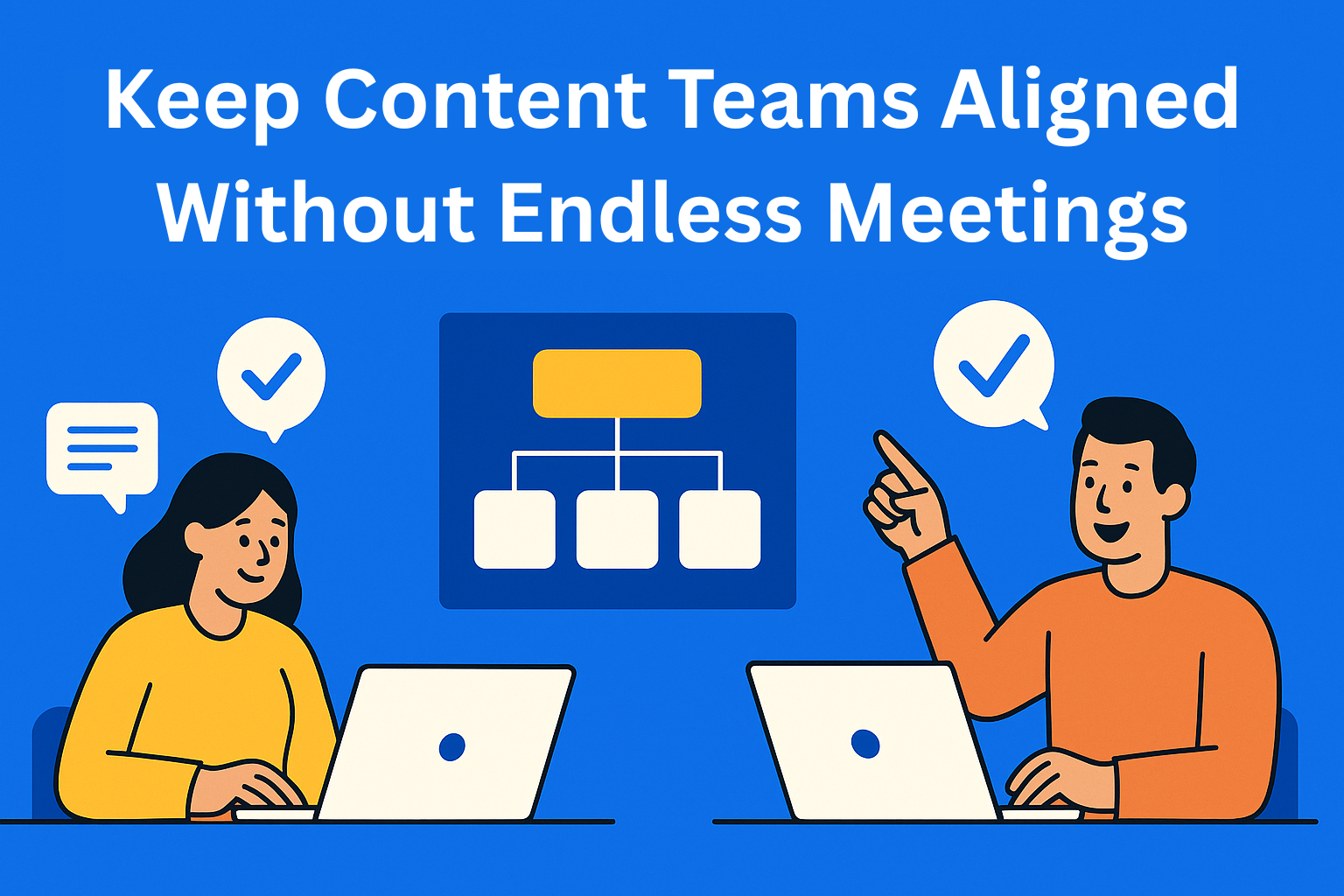How to Keep Content Teams Aligned Without Endless Meetings
Tired of spending more time in meetings than creating content? Learn how shared workflows, clear ownership, and smarter documentation can keep your content team aligned - without the endless calls.

If you work in a content team, you probably know this scene all too well: your calendar is packed with “quick syncs,” “status updates,” and “alignment calls.” By the time you finally close Zoom, half the day is gone - and the content you were supposed to create is still sitting in draft.
Meetings are important, but let’s be honest: most of them don’t need to happen. Worse, they’re often just elaborate ways of repeating what everyone already knows. The truth is, alignment doesn’t have to mean endless meetings. With the right processes and tools, your team can stay on the same page while getting more time back for actual work.
Let’s talk about how.
Key Takeaways
- Meetings drain productivity - Frequent check-ins cause constant context switching and stall content progress.
- Shared workflows boost alignment - Transparent project boards replace catch-up calls and keep everyone informed.
- Clear ownership prevents chaos - Defined roles (writer, reviewer, approver) remove ambiguity and reduce unnecessary calls.
- Documentation replaces repetition - Centralized briefs and guidelines reduce repeated explanations during meetings.
- Reserve meetings for creativity - Use live sessions for brainstorming and feedback, not for basic updates.
Why Too Many Meetings Hurt More Than They Help
The problem with constant check-ins isn’t just the time sink - it’s the context switching. Every time you stop writing to hop on a call, it takes mental energy to reset afterward. Multiply that across an entire team, and you’ve lost hours of productivity each week.
And ironically, the more meetings you have, the less aligned everyone tends to feel. Things get rushed, people talk in circles, and by the end, no one’s quite sure what was decided. If your content calendar feels stuck, chances are the culprit isn’t lack of effort - it’s meeting overload.
1. Use Shared Workflows Instead of Weekly Recaps
Instead of gathering everyone to “catch up,” build a shared workflow that shows exactly where each piece of content stands. If an article is being drafted, reviewed, or designed, the team should be able to see it instantly - without asking.
This way, your content process becomes visible, not verbal. Tools like EasyContent are built for this: you can create workflows with clear stages, assign tasks, and track progress. The best part? Everyone knows who’s up next, so you don’t need a meeting just to answer “Where are we on this blog?”
2. Assign Clear Ownership (So Nothing Gets Lost)
Endless meetings often happen because responsibilities aren’t clear. Who’s editing this piece? Who’s approving the design? If no one knows, you end up gathering everyone to figure it out.
Instead, assign clear ownership at the start of each project:
- One person owns the draft.
- One person owns the review.
- One person owns the final approval.
That’s it. Fewer cooks in the kitchen, fewer meetings to clarify what’s already decided.
3. Document, Don’t Discuss (Every Time)
Not everything needs to be said out loud. Some things just need to be written down. A shared set of guidelines, tone-of-voice docs, or content briefs saves you from explaining the same things over and over again in calls.
For example, instead of a 30-minute meeting about how to handle AI-generated drafts, put those instructions into a content template. EasyContent lets you store these directly inside the content so writers, editors, and designers always have the right information at their fingertips.
4. Replace Status Updates with Dashboards
If your meetings mostly consist of everyone reporting “where they’re at,” here’s some good news: dashboards do that for you. A visual overview of content status (what’s in draft, review, or published) keeps the team aligned without a single word spoken.
Plus, dashboards scale. Whether you’re managing 5 blogs a month or 50, the overview looks the same. You can spend less time talking about content and more time creating it.
5. Save Meetings for What Actually Matters
Does this mean you should abolish meetings altogether? Not at all. Some conversations need a live discussion: brainstorming, creative debates, or sensitive feedback.
The trick is to save meetings for what matters - not for reading out the latest deadlines. Think of meetings as your “premium time.” Use them to solve problems, not to broadcast updates. Your team will thank you (and probably show up with more energy, too).
Conclusion
Endless meetings aren’t a sign of a productive team - they’re usually a sign of a process problem. The good news is, with shared workflows, clear ownership, and better documentation, you don’t need to sit in status calls to stay aligned.
EasyContent makes this easier by putting everything in one place: tasks, guidelines, approvals, and progress tracking. But even if you don’t use a platform, the principle is the same - clarity beats meetings every time.
So next time someone suggests “another quick check-in,” ask yourself: could this be solved with a workflow update or a simple note in the brief? Chances are, the answer is yes.






